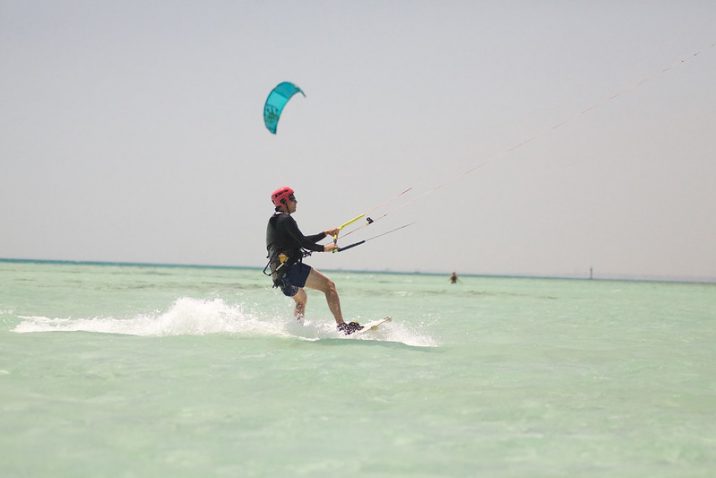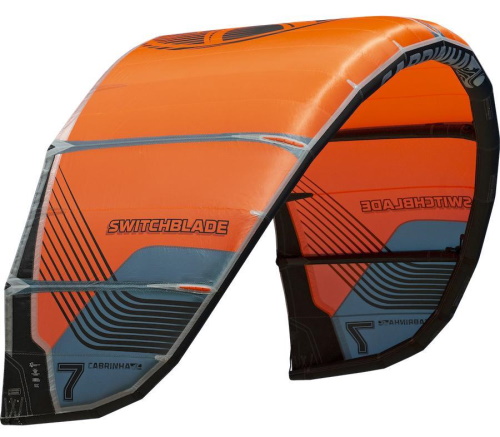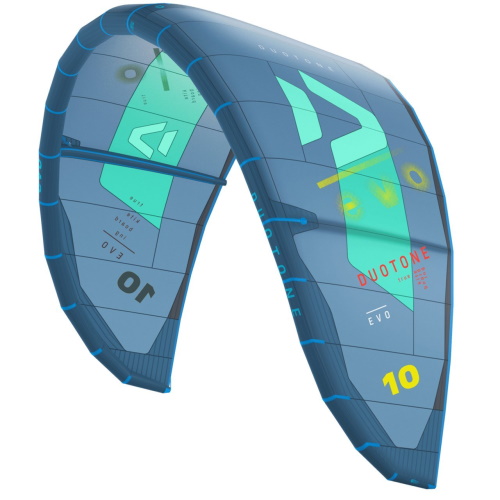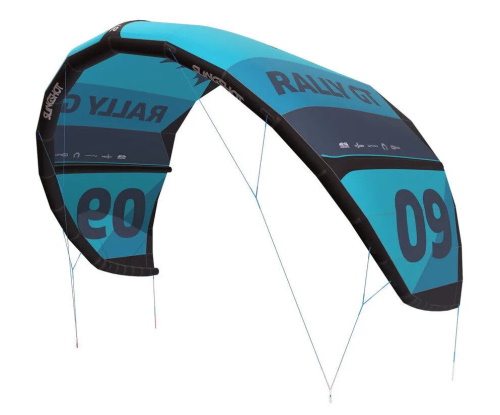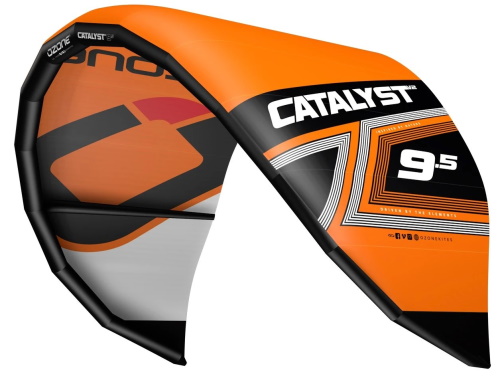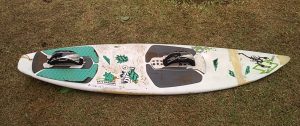If you’re a newer kitesurfer, you’ve probably paid your dues on a school kite that took a lot of abuse from you. Your next stage is to choose the best possible beginner kite that will help you build up your riding and flying skills, and ideally serve you for a while as you progress.
For this post, I’ve selected four kitesurfing kites widely considered among the best for beginners:
| Kite | Description | |
|---|---|---|
| Cabrinha Switchblade | all-time best-selling beginner and freestyle kite | View pricing |
| Duotone Neo | lightweight, 3-strut tried & tested kite for learning and improving | View pricing |
| Slingshot Rally | powerful, beginner-friendly, solid, best relaunch of all | View pricing |
| Ozone Catalyst | Also a lightweight kite, very well-suited for the learner | View pricing |
Before I deep dive into each of the above kite, let’s briefly go over the main things to look for in a good beginner kite.
Essential characteristics of a beginner kite
Stability
A beginner kite should be stable. Drift refers to a kite’s stability when parked, e.g. when depowered and positioned at 12:0. You want your beginner kite to drift with you and not fall out of the window or have its canopy flapping when depowered.
Depower
Your kite should have good depower, which means it should stop dragging or lifting you when you push out or outright let go of your control bar, particularly in stronger winds. Some kites have little depower which can be a big hurdle for beginners.
Upwind capabilities
As a beginner, you’re like to make frequent mistakes in steering your kite and board, which typically results in drifting downwind. Some kites ride upwind with much effort than others due to their shape and design. This is a very helpful ability for learners.
Bar pressure
Some kites have strong bar pressure while others have moderate or low pressure. As a beginner, higher bar pressure is crucial as it gives you more feedback so you can feel where your kite is in the window and where it’s moving at all times. Super low bar pressure can be a handicap for a newer kiter.
Turning speed
Kites that turn fast require more advanced skills to control as they feel less stable and can be more challenging to keep in place e.g. for riding upwind or jumping. As a beginner, you’ll want to learn jumps, so you need a kite that doesn’t overreact to steering mistakes.
Wind range
As a beginner, you’ll likely own a single kite or two kites initially. Thus, you generally want a kite with broad enough wind range to be able to ride in a wide variety of wind conditions at your local spot. Some kites have more low-end and/or high-end range than others, enabling you to ride in a wider range of wind situations.
Pull and relaunch
As a beginner, you’re likely to be crashing your kite frequently. Some kites are much easier and quicker to relaunch in the water than others, and with less wind. Also, some kites offer constant pull when flying, and thus less likely to crash. Constant power even in lower wind is a helpful feature for learning kiters.
Ok, next let’s take a close-up look at our 4 selected beginner kites.
#1: Cabrinha Switchblade
The Switchblade is the world’s most sold kite, for a reason. It’s extremely smooth, easy to power-up, and easy to control for a beginner. Few kites offer as beginner-friendly handling. Newbies who started on a different kite generally get comfortable with the Switchblade very quickly.
The Switchblade greatly facilitates waterstarts for learners because of its stability and high predictability. This makes the kite very forgiving and reduces the impact of steering mistakes for beginners especially.
Durability
The Cabrinha Switchblade is a 5-strut kite with a very sturdy and durable canopy and airframe. It’s known to last for years and withstand abuse exceptionally. Cabrinha’s Nano Ripstop canopy is setting new standards for strength and for steering response.
Relaunch
One of the most attractive feature of the Switchblade for new kiters is its outstanding relaunch capabilities – the Switchblade relaunches very fast and reliably. In most cases, with the kite “face down” on the water, all you need to do is pull on a back line to get the kite rolling onto its wingtip and shooting straight into the air.
For this reason, the Switchblade is among the safest kites out there for beginners riding in irregular wind, as it will typically be the first to relaunch with the least amount of wind – and the last one to crash when the wind drops.
Wind range & depower
The Switchblade is also renowned for its extensive wind range. Learners who can only invest in one or two kites initially find the Switchblade to be a compelling option.
The Switchblade offers constant constant pulling across its range, and exceptional low-end power. I often go 1/2 to 1m2 smaller for a Switchblade than for other kites. A beginner will get more pull and power in low wind from a Switchblade than say a similar sized Dutotone Neo.
While the Switchblade has decent depower, its “boostiness” and strong pull power in the low range makes it less comfortable than other kites in the high end of its range. With 180lb, I can fly a 9m2 Switchblade in 25 knots fully trimmed, but it’s not the most comfortable experience.
Bar pressure
The Switchblade has significant bar pressure, unlike others Cabrinha kites like the Drifter. While this may be perceived by more advanced riders as a drawback, it’s actually a plus for beginners who are always able to feel with precision where the kite’s sits in the window.
Jumping
The Switchblade is also an awesome kite for learning to jump. It’s very boosty and helps you reach greater heights faster. Yet, it’s predictable and forgiving in the face of beginner mistakes, such as steering too hard into the opposite half of the window during a jump.
Progression
As learners progress past the initial learning stage, the Switchblade remains relevant and lets them work on tricks while remaining stable and powered-up in the window even across gusts and lulls. This kite has very good hangtime which gives the newer rider confidence to push things further.
Check out the Cabrinha Switchblade here on Green Hat
#2: Duotone Evo
The Duotone Evo is also a great entry kite. Like the Switchblade, it’s extremely forgiving, stable and predictable, has a huge wind range, and can help a learner progress for a long time.
Construction
The Duotone Evo is a 3-strut kite, making it much more lightweight than the Switchblade – the 2020 9m2 Evo is close to .6lb lighter than the equivalent SB. This is reinforced by the reduce wingtip size and Duotone’s new lightweight fabric for the trailing edge.
The newer Evo now has a fixed bridle instead of pulleys as in earlier versions, making the kite a lot more responsive without loosing depower.
Wind range
Similar to the Switchblade, the Evo has a broad wind range – an average sized beginner kiter may be able to ride on a 9m kite in 18 knots as well as in 30 knots. This allows a learner to start with fewer kites for a given wind range.
Like the SB, the Evo is easy to control for a beginner kiter. The stable pull on this kite across wind fluctuations facilitates the learning. The Evo maintains good turning abilities when low powered, helpful for learning to turn and switch directions.
Bar pressure & depower
The Evo has a lighter feel compared to the Switchblade with much lighter bar pressure – yet enough of it for a newbie to still feel the presence of the kite in the window.
Compared to the Switchblade, the Evo feels much more responsive and fast-turning, due to its 3-strut design and higher aspect ratio. The Evo also has significant amounts of depower, broadening the wind range on the high end.
Progression
While it’s very beginner-friendly, the Evo is a very versatile and progressive kite. The high amount of depower and responsiveness of this kite makes it suitable for kite foiling and wave kiting, as well as big jumps and freeride – the Evo has lots of lift and hangtime.
Thus, a beginner can generally continue to ride this kite past the initial learning stages.
Relaunch, upwind
The Evo has very good and easy relaunch, making this kite beginner-friendly in unstable winds. This is due in part to the kite’s Delta design which prevents it from “sticking” to the water.
The delta shape also gives the Evo very good upwind capabilities.
Check out the pricing for the Duotone Evo here on Green Hat Kiteboarding
#3: Slingshot Rally
Like the Switchblade and Evo, the Rally is also praised for its stability, predictability, easy relaunch, broad wind range, and smooth power delivery.
It’s also easy to jump and has very good hangtime.
Upwind and turns
The Rally has very good upwind capability. It’s slower turning than the Slingshot RPM, which is an advantage for a learner – very fast kites are more sensitive in steering and easier to overshoot.
Wind range & power
The Rally, like the Switchblade, is a 5-strut kite which makes it heavier. The minimum wind threshold to fly it is thus higher than on a lighter kite. That said, the Rally has a pretty broad range. Depending on your weight and skills, you can fly a 10m Rally from 12 to 22 knots.
The Rally is easy to power-up for a beginner who can simply dive the kite slightly and start riding. This is in contrast to the RPM, for example, which requires large movements to generate power
Compared to other Slingshot models, the Rally has better low-end power, including the smaller kites. The low-end grunt comes in handy for a beginner in underpowered situations. In wind lulls, simply moving the Rally across the window generate strong power boosts beginners welcome.
The Rally also has a solid high end and handles strong winds very well with a stable feel for the beginner rider.
Bar pressure
The Slingshot Rally has relatively strong bar pressure, similar to the Switchblade. This again greatly helps the learner know where their kite is, giving them more direct feedback compared to a pulley-based systems (e.g. the older Evos).
Light pressure bars are not well-suited for newer kiters who haven’t yet developed a feel for where their kite is at any given time. The lack of direct feedback often leads to steering mistakes and crashes.
Relaunch and stability
The rally has very good and quick relaunch even in light wind. It also won’t drop easily from the window even with slack in the lines. This is an important feature for beginners who may not maintain tension in the lines at all times, e.g. in wind lulls or when riding fast towards the kite.
Progression
The Rally is well-suited for wave riding thanks to its drifting ability, decent turning, quick relaunch, and a build strong enough to withstand some wave pounding after a crash. Like to the Evo, the Rally is a good versatile kite that can serve you long past the learning phase.
Check out the Slingshot Rally on Green Hat.
Note: if you’re already past the beginner stage, you can also check out the newer 3-strut Rally GT, a slightly more advanced and performance-oriented evolution of the GT – also a great all-around kite.
#4: Ozone Catalyst
The Ozone Catalyst is also a very good learning kite with a focus on easy handling as opposed to pure performance. Like the other kites selected in this post, it’s extremely stable and very forgiving, making it a good choice at different learning levels.
The Catalyst is a 3-strut delta-shaped kite with a relatively low aspect, e.g. compared to the Evo. Reliability and predictability are its main traits.
Relaunch
The Catalyst provides among the easiest water relaunch. This again is a crucial feature for new kiteboarders. The relaunch on this kite is a lot easier than other kites like the Ozone Edge. The Catalyst launches from the edge of the window rather than the middle, making the relaunch softer.
Wind range & depower
The Catalyst handles wind gusts in a smooth and predicable manner. Similar to the Rally, the Catalyst is easily powered-up without the need for a lot of hard steering.
Bar pressure & turning
The Catalyst has relatively strong bar pressure, which is well-suited for beginners who don’t yet have an instinct for where the kite is located in the window. A bar with stronger presence makes the steering more intuitive for learners.
The Ozone’s Contact is a very beginner-friendly control bar which stands out for its ease of reassembly after a release.
It’s a very stable kite that doesn’t easily overfly the window and requires blunt steering input to initiate turns – again a good thing for a beginner as it makes steering a lot more forgiving and confidence-boosting.
Progression
Many people agree the Catalyst is a good option that helps the new kiter build up confidence and progress faster.
Past the initial learning stages, the Catalyst also works well for riding waves and foiling. It’s also a nice predictable jumper, though not as boosty as other kites like the Switchblade or the Edge. It’s a well-suited kite for riders looking to build up jumping skills.
See the Ozone Catalyst here on Green Hat (PROMOTION)
So which kite to choose as a beginner?
The Switchblade, Evo, Rally, and Catalyst were selected because they have several common characteristics which are very well-suited for beginner riders – namely stability & predictability, wind range, depower, relaunch, bar pressure.
However, there are also important differences between these kites. The Switchblade and the Rally are both grunty kites – more so than the Evo and Catalyst. They are also heavier 5-strut kites compared to the 3-strut Evo and Catalyst. Kite weight is an important factor.
Due to its being super grunty, the Rally is best suited for heavier riders e.g. 200+ lbs. The Switchblade is next in terms of grunt, and is best for riders above 155-160 lbs – including for smaller kite sizes.
The 3-strut Evo is a bit lighter and typically works best for lighter riders. It has good staying power through wind lulls. Note that smaller kites have more density (weight per square meter) compared to bigger sizes, so they tend to fall out of the sky sooner in lulls.
The Switchblade and the Rally have heavier bar pressure than the other two kites. The pressure on the Evo bar is noticeably lower.
The Rally is probably the best relaunching kite on the market.
***
Photo credits:
Featured image: “IMG_5568” by Axel-E-Rator


